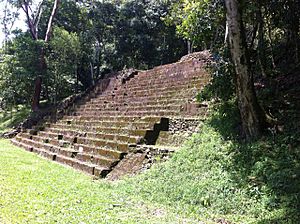Rio Amarillo (Mayan Site) facts for kids
Rio Amarillo, also called La Castellona or La Canteada, is an ancient Maya city in Honduras. It's an archaeological site from the Classic Period of Maya history. This large city was a busy stop for Maya travelers. It also shows us how the Maya civilization started to decline. Rio Amarillo was the very last Maya city in Honduras to be left empty at the end of the Classic Period.
Where is Rio Amarillo?
The ruins of Rio Amarillo are in a place called Santa Rita. This is in the Copan area of western Honduras. It's about 20 kilometers (12 miles) northwest of the famous Copan Ruins.
History of the City
People believe that Rio Amarillo was first settled around 400 BC. Even from the start, important buildings like houses and pyramids were built here. However, these buildings were not as big or fancy as those you can see at the Copán archaeological park or El Puente. Because of this, experts think Rio Amarillo was built around the same time as early Copan, before its main kings ruled.
Rio Amarillo was likely a stopping point for Maya travelers. They used it on their journeys between the El Florido valleys in Honduras and the El Motagua valleys in Guatemala. The buildings here show amazing ways the ancient builders put stones together.
The site also shows the sudden end of the Maya culture. Some buildings were left half-finished. This has helped archaeologists learn about the building methods the Maya used. They can study how stones were carved and placed, what tools were used, and what materials held them together. It also makes them think about how all this building might have affected the environment, leading to the Maya decline.
What Was Found Here?
Rio Amarillo has 53 main structures. These are arranged in squares, courtyards, and terraces. The city also had areas for homes, a central part, and a special area for ceremonies.
About 145 burials have been found here. These contain the remains of ancient Maya people. Because of the jewelry, clothes, and other valuable items found with them, experts believe these people were important. They might have even been part of the wealthy families from Copan. Inside the underground passages, you can still see stucco masks. These masks still have their original paint, much like those found in the famous Rosalila temple at Copan.
See also
 In Spanish: Río Amarillo (Honduras) for kids
In Spanish: Río Amarillo (Honduras) for kids


